Related Research Articles

The Samsung SGH-U600, introduced in 2007, is a mobile phone manufactured in South Korea by Samsung and is part of the Ultra Edition II series of Samsung phones. It is a sliding phone and the thinnest phone of its time. One of its main features are the call and select buttons, which are touch-sensitive instead of physical buttons.
A mobile operating system is an operating system for smartphones, tablets, smartwatches, smartglasses, or other non-laptop personal mobile computing devices. While computers such as typical laptops are "mobile", the operating systems used on them are generally not considered mobile ones, as they were originally designed for desktop computers that historically did not have or need specific mobile features. This line distinguishing mobile and other forms has become blurred in recent years, due to the fact that newer devices have become smaller and more mobile unlike hardware of the past. Key notabilities blurring this line are the introduction of tablet computers and light-weight laptops and the hybridization of the two in 2-in-1 PCs.

The Samsung SGH-i900, also known as Omnia I or WiTu, is a smartphone created by Samsung Mobile. Announced in June 2008, the Omnia was launched in Singapore in mid-June, available in stores on the 20th of June, and in the rest of Asia in July. For some parts of Europe, it was launched in August. It was made available for the United States in December 2008 through Verizon Wireless and for Canada in April 2009 through Telus Mobility.

The Samsung SGH-F480 is a touch-screen mobile phone announced in February 2008 and released in May 2008 by Samsung Mobile. The F480 is available from Orange, T-Mobile, 3, Virgin Mobile, Telstra, Optus, and O2 mobile carriers under both contract and prepaid plans. Models without a SIM lock are also available. It comes in three colours: black, pink, and gold.

The Samsung Behold SGH-T919 is a touch-screen, 3G candybar-style mobile phone introduced by Samsung late in 2008. The Behold is one of the first Samsung mobile phones released to have a touch-screen along with the Samsung Omnia, the Samsung Instinct, the Samsung Eternity, and the Samsung Tocco. The Behold is the "American" release of Samsung Tocco, which is only sold in Europe, Asia and Australia so the features and design of both of these phones are similar. Some of the Behold's biggest competitors were Apple's iPhone, T-Mobile G1, LG Dare, Samsung Instinct, and Samsung Eternity. It was only available only to customers of T-Mobile.
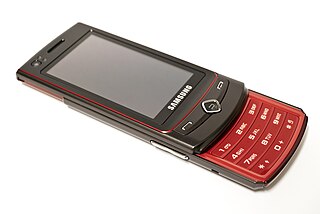
The Samsung S8300 is a high-spec mobile phone model from Samsung Telecommunications, released over April 2009. Renowned for its AMOLED touch-screen display and 3x4 optional keypad input, The Samsung S8300 is acclaimed to be one of the better Samsung mobile phones to date. The phone has a vast array of features such as; an 8.0-megapixel camera with video recording and an integrated music player.

The Samsung Moment, known as SPH-M900, is a smartphone manufactured by Samsung that uses the open source Android operating system.
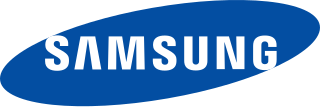
The Samsung Wave is a smartphone developed and produced by Samsung Electronics. It is the first smartphone to run the Bada operating system developed by Samsung Electronics, which was commercially released on May 24, 2010. The Wave is a touchscreen phone powered by Samsung's "Hummingbird" CPU (S5PC110), which includes 1 GHz ARM Cortex-A8 CPU and a built-in PowerVR SGX 540 graphics engine. It also has a "Super AMOLED" screen and 720p high-definition video capture capabilities. Due to shortage of Super AMOLED screens, Samsung released a successor to the device called Wave II and ceased production of the original S8500 model.

The HTC Evo 4G is a smartphone developed by HTC Corporation and marketed as Sprint's flagship Android smartphone, running on its WiMAX network. The smartphone was launched on June 4, 2010. It was the first 4G enabled smartphone released in the United States.

The Samsung Galaxy S is a touchscreen-enabled, slate-format Android smartphone designed, developed, and marketed by Samsung Electronics; it is the first smartphone of the Samsung Galaxy S series. It is the first device of the third Android smartphone series produced by Samsung. It was announced to the press in March 2010 and released for sale in June 2010. Due to shortage of Super AMOLED displays, Samsung released a successor to the device called S scLCD or SL and ceased production of the original I9000 model.

TouchWiz was a user interface developed by Samsung Electronics Co., Ltd with partners, featuring a full touch user interface. It is sometimes incorrectly referred to as an operating system. TouchWiz is used internally by Samsung for smartphones, feature phones and tablet computers, and is not available for licensing by external parties. The Android version of TouchWiz also comes with the Samsung-made app store Galaxy Apps. It was replaced by Samsung Experience in 2017 with the release of Android 7.1.1 “Nougat”.

The Samsung Infuse 4G was an Android smartphone that was released by Samsung in May 2011. It has a 1.2 GHz Hummingbird processor with 8–16 GB internal Flash memory, a 4.5 inch 480×800 pixel Super AMOLED Plus capacitive touchscreen display, an 8-megapixel camera and a 1.3-megapixel front-facing camera.
The HTC Evo Shift 4G is a smartphone developed by HTC Corporation and marketed as the concurrent/sequel to Sprint's flagship Android smartphone, running on its 4G WiMAX network. The smartphone launched on January 9, 2011.
The Samsung Galaxy S 4G LTE also known as the Droid Charge (Verizon), Galaxy S Aviator and Galaxy S Lightray 4G, it was an Android smartphone manufactured by Samsung. It has a 1 GHz "Hummingbird" processor, front and rear cameras, and CDMA and 4G LTE radios. It was announced at CES 2011 under the name Samsung Galaxy S 4G LTE device. It is available from Verizon Wireless.
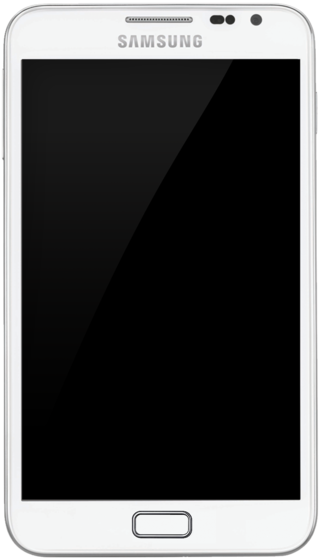
The Samsung Galaxy Note is an Android smartphone produced by Samsung Electronics. Unveiled at IFA Berlin 2011, it was first released in Germany in late October 2011, with other countries following afterwards. The Galaxy Note was distinguished by its unusually large form factor—later referred to using the term "phablet"—which straddled the size of the average smartphone at the time, and that of a small tablet: it features a 5.3-inch display, and is bundled with a stylus branded as the "S Pen", which can be used to navigate the device's user interface, and write or draw in supported apps.

Samsung Galaxy W (i8150), also known as Samsung Wonder, is an Android smartphone that is a smaller-sized variant of Samsung Galaxy S II.
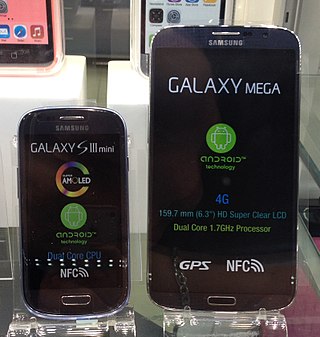
The Samsung Galaxy Mega is an Android-based phablet that was manufactured and released by Samsung. It was announced on April 11, 2013. The original model featured a 6.3 in (160 mm) screen, though a revised version was released with a 5.8 in (150 mm) screen. It has a 1,280×720 screen, a dual-core 1.7 GHz processor and an 8-megapixel camera. The phone runs Android 4.2.2 "Jelly Bean" software, and internal storage is 8 or 16 GB.
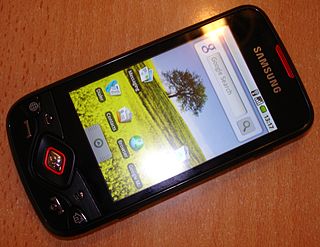
The Samsung Galaxy Spica, also known as Samsung Spica, Samsung GT-I5700, Samsung Galaxy Lite and Samsung Galaxy Portal, is a smartphone manufactured by Samsung that uses the open source Android operating system. The phone is positioned below the Samsung Galaxy (original). Even though some of its features like the camera resolution, storage and data connection speeds are lower than the i7500 its processor's clock speed is much higher at 800 MHz. It is succeeded by the Samsung Galaxy 3.

The Samsung Galaxy A5 (2015) or Samsung Galaxy A5 2015 Edition is an Android smartphone produced by Samsung Electronics. Serving as a premium upper mid-range device, it was introduced on 30 October 2014, along with the smaller and related Samsung Galaxy A3 (2015) and larger Samsung Galaxy A7 (2015) introduced later in January 2015. The Samsung Galaxy A5 (2016) is a successor to the Samsung Galaxy A5 (2015) edition, featuring a revised metal and glass build that debuted with the Galaxy S6.
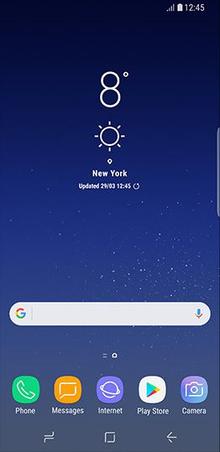
Samsung Experience was a software overlay for the Android "launcher" by Samsung for its Galaxy devices running Android 7.x “Nougat” and Android 8.x “Oreo”. It was introduced in late 2016 on a beta build based on Android 7.0 “Nougat” for the Galaxy S7, succeeding TouchWiz. It has been succeeded in 2018 by One UI based on Android 9 “Pie” and later versions.
References
- ↑ Samsung SGH-t939 Behold II Specs
- ↑ Twitter: Please see our official reply on the Behold II Android 1.6 upgrade announcement.
- ↑ Samsung Behold II for T-Mobile Announced, Mobile Guerilla
- ↑ CNET, T-Mobile introduces Android-powered Samsung Behold II, Bonnie Cha (senior editor for CNET)
- ↑ "F488 TOUCHWiZ Mobile Phone TOUCHWiZ F488 - 3.5G (HSDPA) Phone - mobile Phones | SAMSUNG". Archived from the original on 2009-03-02. Retrieved 2009-11-04. TouchWiz F488 www.samsung.com
- ↑ “Samsung Behold 2”, Cell Phone Reviews, News, Specs and Info, www.phonearena.com
- ↑ Detailed Technical Specifications of Samsung SGH-t939 Behold II
- ↑ Samsung planning Android 1.6 update for Behold II -- but that's it
- ↑ Samsung Behold II fails to fulfill Android 2.0 promise, jilted users contemplating lawsuit (video)
- ↑ Samsung Behold II Not Getting 2.x - Legal Action Being Considered
Jackson, Rob. “Samsung Behold 2: T-Mobile Android With TouchWiz UI!.” Phandroid:android phone fans. http://phandroid.com/2009/10/05/samsung-behold-2-t-mobile-android-with-touchwiz-ui/